Free MAP 6th Grade Practice Test (Math, Reading, Language Usage & Science)
See sample MAP test questions designed to match the skills and style your child will face in 6th grade.

Hey there! Do you have a question about the test or our practice package? Email me at roman@staggingapps.website. I'm here to help your child succeed!
Quick Overview of the MAP 6th Grade Test & How It’s a Big Transition for Your Child
The MAP Growth test for 6th grade includes three or four sections: Math, Reading, Language Usage (also called Language Arts or ELA), and sometimes Science, depending on the school.
(We’ll explain each section in more detail later on.)
This test doesn’t have a time limit and adjusts as your child answers. The number of questions ranges from 40 to 43.
When your child gets a question right, the next one will be harder. If they miss a question, the next one will be easier.
The difficulty shifts based on performance and can range from below grade level to well above it.
If a 6th grader struggles with several questions, the test may show them questions at a 3rd or 4th-grade level.
On the other hand, if they do well, they might see high school-level questions, sometimes even as advanced as 11th- or 12th-grade.
We’ve organized the practice questions below in the same way so you and your child can get a sense of how this works in real time.
Why the MAP 6th Grade Test Is a Big Transition for Your Child
The 6th grade MAP test marks a key shift in how your child is assessed, especially in math.
Up to 5th grade, students take the Math 2–5 test, which includes questions designed for younger learners. But starting in 6th grade, they move to the Math 6+ test, which uses a completely different set of questions.
These questions are more advanced and align with middle school and high school math standards.
This change means your child may face new types of problems they haven’t seen before, even if they’ve done well on earlier MAP tests.
In reading, the transition is a little smoother. Both the 2–5 and 6+ reading tests pull from the same pool of questions, so the style of reading passages stays consistent, but the difficulty still adapts to your child’s level.
Understanding this transition can help you support your child by focusing on the skills and concepts that will come up on the more advanced 6+ test.
Free MAP 6th Grade Practice Test (Math, Reading, Language, and Science)
Try the sample questions below with your child to get them used to the types of questions they might see on the test. These examples are pulled from our full practice package.
NWEA MAP 6th Grade Math Practice Questions
The NWEA MAP Math test measures a student’s ability to understand and apply mathematical concepts, from number operations to algebra and geometry. Its purpose is to identify a student’s current math skill level and track their growth over time, even beyond their grade level.
Here are the main skills and standards that the 6th-grade MAP Math test evaluates. Use this table to understand what your child is expected to know and to identify trouble areas.
| Operations and Algebraic Thinking | The Real and Complex Number Systems | Statistics and Probability | Geometry |
| Calculate the power of tens | Multiply and divide fractions, decimals, and mixed numbers | Create and interpret line plots with fractions | Calculate the area and perimeter of quadrilaterals |
Evaluate and write variable and numerical expressions | Analyze and answer questions with coordinate planes | Calculate mean, median, mode, and range | Find the volume and surface areas of cubes and rectangular prisms |
| Solve one-step equations | Solve percentage problems | Create and interpret stem-and-leaf plots | Identify complementary, supplementary, vertical, and adjacent angles |
| Evaluate and identify linear expressions | Convert and solve multi-step problems with unit conversions | Find the probability of simple events | Find the area of triangles |
Below-Grade-Level Sample Question
Calculate the area of the ABCDEF figure, if AF=3, FE=2, ED=4, DC=1.
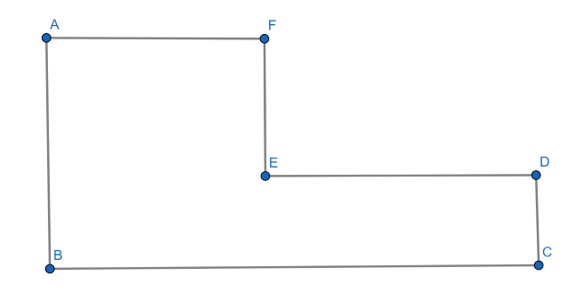
Show Solution
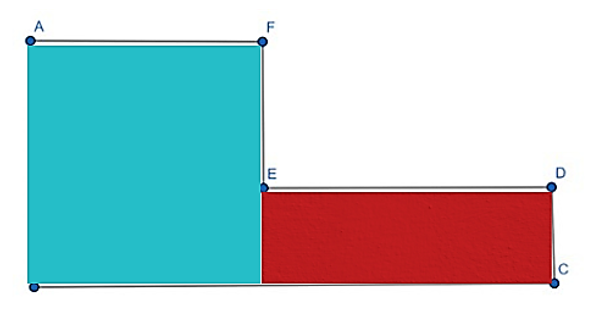
The correct answer is E – 13.
To calculate the total area of the figure, we need to divide it into two smaller sections and then add their areas together. The left section is a square with sides measuring units 3 on each.
AF=3 units multiplied by FE=2 + DC =3 units. So, the left section has an area of 9 square units. While the right section is a rectangle with length ED=4 and width DC=1. To get to its area we multiply the length by its width (4 x 1).
So, the area of the figure on the right is 4 square units. Finally, the total figure must be the sum of the two areas, which is 9 square units plus 4 square units, which is 13 square units.
At-Grade-Level Sample Question
The pictogram shows information about the houses in a street. There are three kinds of houses: 3-bedroom, 4-bedroom, and 5-bedroom. Use the pictogram to determine the total number of houses in the street.
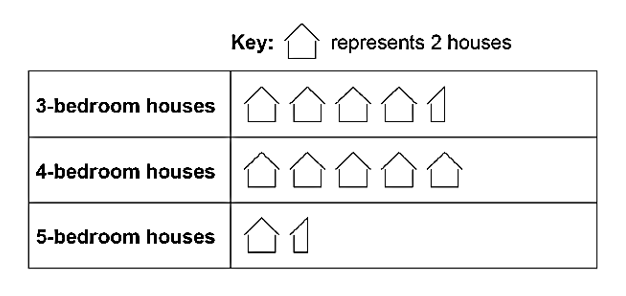
Welcome to your trusted practice resource for the 2025 NWEA MAP 6th Grade Test!
If your child is taking the MAP test in 6th grade, you might be wondering how to support them through it.
This guide covers everything, from why 6th grade marks a big testing shift to free practice questions in math, reading, language, and science.
You’ll also learn how to make sense of the scores, which help schools measure growth, spot advanced learners, and place students in gifted or enrichment programs.
Let’s get started!
Show Answer
The correct answer is B – 22.
The total number of houses as they are represented by the table below is as follows:
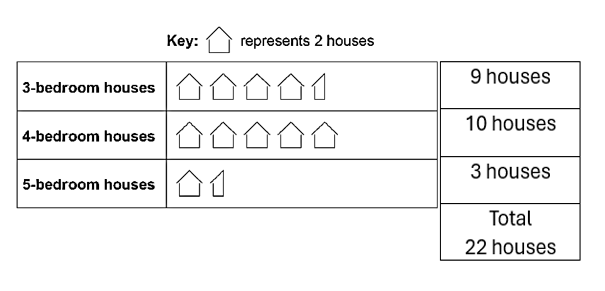
Above-Grade-Level Sample Question
The table shows the number of days when it rains each month.
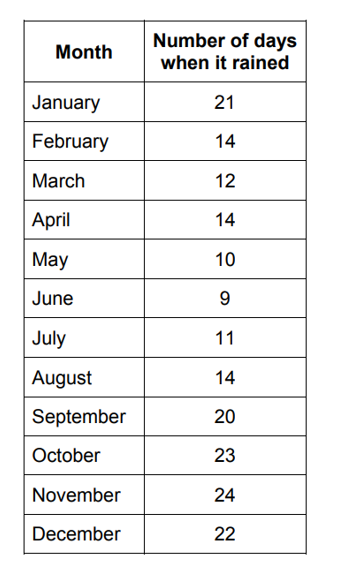
What is the mode and range of this data?
Show Solution
The correct answer is D.
First, let’s find the mode:
The mode is the value that occurs most often.
Tally up how many times each number appears:
- 9 appears once
- 10 appears once
- 11 appears once
- 12 appears once
- 14 appears three times (Feb, Apr, Aug)
- 20, 21, 22, 23, 24 each appear once
Since 14 occurs more often than any other number (3 times),
Mode = 14 days.
Finding the range:
The range is: (maximum value) − (minimum value)
- Minimum rainy days = 9 (June)
- Maximum rainy days = 24 (November)
So,
Range = 24 − 9 = 15 days.
Is math feeling tough for your child? They’re not alone.
Plenty of students face challenges with math, but steady practice can make a big difference.
Start with just a little each day – progress adds up quickly, and confidence grows with every small win.
Want to help your child feel stronger in math?
Our practice pack includes more than 140 skill-focused questions made to support their learning and improve their scores.
Boost Your Child's MAP Test Scores
Help your child prepare with a complete practice package designed to maximize their performance on the MAP 6th Grade test.
Build Confidence with 3 Full-length Simulations
Master All Test Areas with 18 Quizzes in Varying Levels
Gain an Edge with Expert-Created Resources
NWEA MAP 6th Grade Reading Practice Questions
The NWEA MAP Reading test evaluates how well a student can understand, analyze, and interpret written texts. It helps teachers determine reading comprehension levels and identify areas where students may need more support or greater challenge.
Below is a table summarizing the main topics and skills your child will be tested on:
| Literary Text | Informational Text | Vocabulary |
| Analyze short stories | Analyze Central Idea, Concepts, and Events | Prefixes and Suffixes |
| Identify the narrative point of view | Analyze Point of View, Purpose, Features, and Structure | Determine the meaning of words using context clues |
| Determine the themes of short stories | Compare information from two texts | Synonyms and antonyms |
| Use dictionary entries and definitions |
Below-Grade-Level Sample Question
Read the story.
The magician stood in front of the audience, preparing for his big trick. He asked his assistant to bring the box on stage. The assistant set the box down, but when the magician tried to open it, it was locked! The audience waited eagerly, and the magician looked around at his team. “Who locked the box?” he asked. The assistant said, “I didn’t do it!” The juggler pointed to the clown and said, “Maybe it was him!” The clown shook his head and laughed. “I would never lock the box!” The magician frowned and tried to open the box again. He pulled out a large key from his coat pocket and unlocked the box. The audience cheered, and the magician took a bow.
Who most likely locked the box in this story?
Show Solution
The correct answer is: C. The magician
The magician had the key to unlock the box, which suggests that he may have locked it himself as part of the trick. It’s possible he locked it earlier to add suspense to his performance.
Choice A. This choice is incorrect. The clown was not responsible for locking the box. The juggler only pointed to him but did not provide evidence that the clown locked it. In fact, the clown denied locking the box.
Choice B. This choice is incorrect. The assistant did not lock the box; he simply set it down on stage. There is no indication in the story that he was the one who locked the box.
Choice D. This choice is incorrect. The juggler pointing to the clown does not mean that the juggler locked the box. He was only suggesting the clown as a possible person who locked it. The juggler did not play a direct role in locking the box.
At-Grade-Level Sample Question
Read the speech.
My fellow citizens, I stand before you today to address one of the most pressing issues in our community—access to clean drinking water. Water is a basic necessity of life, yet many of our neighborhoods face challenges in getting clean, safe water.
I believe it is our responsibility to fix this problem. If elected, I will prioritize upgrading the old water systems that are causing contamination. I also plan to implement community water-testing programs so that families can ensure their water is safe to drink.
Clean water is not a luxury; it is a right. By focusing on this issue, we can improve the health of our families, especially our children, who deserve to grow up without fear of illness caused by something as essential as water. Together, we can build a future where everyone in our community has access to clean, safe water.
Which of the following is the best summary of the speech?
A. The speaker wants to solve the issue of unsafe water by fixing old water systems and offering testing programs to ensure clean water for all.
B. The speaker plans to fix water systems so children can have plenty of water for playing and gardening in their neighborhoods.
C. The speaker says water is important and believes families should save water whenever possible to avoid waste.
D. The speaker thinks clean water is expensive, so families need to buy bottled water instead of using tap water.
Show Solution
The correct answer is: A.
This is the correct answer because it completely and accurately summarizes the speech. It identifies the problem (unsafe water), the solutions (fixing water systems and offering testing programs), and the goal (ensuring clean water for all).
Choice B. This choice is incorrect because it includes ideas that were never mentioned in the speech. The speaker focuses on clean drinking water, not water for playing or gardening.
Choice C. This choice is incorrect because it changes the main focus of the speech. The speaker talks about solving water contamination, not about saving water or avoiding waste.
Choice D. This choice is incorrect because it completely misrepresents the speech. The speaker never suggests buying bottled water and emphasizes improving water systems instead.
Above-Grade-Level Sample Question
Read the sentences.
The theatre erupted with boisterous applause as the performers took their final bow. The audience clapped, cheered, and even stomped their feet, filling the grand hall with an overwhelming wave of sound and excitement.
Based on the sentences, what is the meaning of the word “boisterous”?
Show Solution
The correct answer is: B.
Boisterous means full of energy, excitement, and noise. In the passage, the audience is clapping, cheering, and stomping their feet, which shows they are being cheerful and noisy rather than quiet or angry.
Choice A. This is incorrect. The passage describes an audience that is clapping, cheering, and stomping their feet, which is the opposite of being quiet and calm. If the crowd were quiet, there would be no loud applause or excitement.
Choice C. This is incorrect. Focused and serious means paying close attention and behaving in a thoughtful way. However, the audience is celebrating and making noise, not concentrating or staying serious.
Choice D. This is incorrect. While boisterous can mean loud, it does not mean angry. The audience in the passage is cheering and excited, which suggests happiness, not anger. If they were angry, they would likely be booing or shouting in frustration instead of applauding.
NWEA MAP 6th Grade Language Usage Practice Questions
The NWEA MAP Language Usage test focuses on grammar, punctuation, sentence structure, and writing skills. Its purpose is to assess a student’s command of language mechanics and support targeted instruction to strengthen written communication.
Here’s a table outlining some of the key components of the NWEA MAP 6th Grade Language Usage section:
| Language: Understand, Edit for Grammar, Usage | Language: Understand, Edit for Mechanics | Writing: Write, Revise Texts for Purpose and Audience |
| Parts of Speech: Pronouns and antecedents, Subject and object pronouns, Personal and reflexive pronouns, Past, present, and future tense, Progressive and perfect tense. | Punctuation: Commas, Restrictive and nonrestrictive elements, Semicolons, colons, and commas, Dashes, hyphens, and ellipses | Plan, Organize, Create Cohesion, Use Transitions |
| Phrases, Clauses, Agreement, Sentences | Spelling: Homophones, Regular plurals, Possessive nouns, Past tense, Adjectives and adverbs, Contractions, Frequently confused words | Provide Support, Develop Topics, Conduct Research |
| Establish and Maintain Style, Use Precise Language |
Below-Grade-Level Sample Question
Which of the following sentences uses an apostrophe incorrectly?
Show Solution
The answer is D.
In the sentence “The cat’s whisker’s are unusually long,” the apostrophe in “whisker’s” is incorrect because it is not a possessive form and should simply be “whiskers.”
The other sentences correctly use apostrophes to indicate possession: “children’s,” “book’s,” and “teachers’.”
At-Grade-Level Sample Question
Which of the following words is the correct plural form of “thesis”?
Show Solution
The correct answer is C.
“Theses” is the proper plural form of “thesis.” The word follows an irregular pluralization rule where the “-is” ending is replaced with “-es.”
Options A and D are incorrect as they do not follow the pluralization rules, and B is singular, not plural.
Above-Grade-Level Sample Question
Which of the following is a suitable research question about the cultural impact of music?
A. When was the first piano made?
B. How did jazz music influence the civil rights movement?
C. Which genre of music is more popular, classical or pop?
D. D. What are the physical differences between a trumpet and a trombone?
Show Solution
The correct answer is B.
This question is suitable for research because it explores the broader cultural and historical impact of music, specifically focusing on jazz and its role in shaping societal movements.
Research questions like this allow for a deeper analysis of music’s influence on culture, society, and history.
The other options are not as relevant for cultural research: (A) focuses on historical facts, (C) is opinion-based and subjective, and (D) is a technical comparison of instruments rather than a cultural inquiry.
Give Your Child the Tools to Excel & Score High
Get the complete practice package and access 430 Practice Questions & Explanations in Math, Reading, and Language Usage.
Only $49
NWEA MAP 6th Grade Science Practice Questions
The NWEA MAP Science test for 6th Grade is an optional section that some schools include to measure a student’s understanding of key scientific concepts across life, physical, and earth sciences. Its purpose is to assess how well students apply scientific thinking and interpret data.
Below-Grade-Level Sample Question
A breeder wants to cross two rabbits. One has black fur and the other has white fur. Black fur (B) is dominant over white fur (b).
The breeder uses a Punnett square to predict the outcome of the cross between a black-furred rabbit (heterozygous) and a white-furred rabbit (homozygous recessive).
Below is the Punnett square:
| B | b | |
|---|---|---|
| b | Bb | bb |
| b | Bb | bb |
What is the chance that an offspring will have white fur?
Show Solution
The correct answer is (C) – 2 out of 4.
Parent genotypes:
Black-furred parent (heterozygous): Bb
White-furred parent (homozygous recessive): bb
Gametes:
Bb gives gametes: B and b
bb gives gametes: b and b
Punnett square results:
Bb (black)
Bb (black)
bb (white)
bb (white)
Phenotypes:
2 offspring are Bb (black fur)
2 offspring are bb (white fur)
Answer:
The probability of white fur is 2 out of 4, or 50%.
At-Grade-Level Sample Question
In August, a student sees the constellation Cygnus high in the eastern sky at 9:00 P.M. Two months later, in October, they notice that Pegasus now appears in the same part of the sky at the same time.
Below are the observations:
| Month | Constellation | Time | Location in Sky |
|---|---|---|---|
| August | Cygnus | 9:00 P.M. | Eastern sky |
| October | Pegasus | 9:00 P.M. | Eastern sky |
Why does the student see different constellations at the same time of night as the months change?
Show Solution
Correct Answer: D. Earth orbits the Sun, changing the night sky view
As Earth revolves around the Sun, our night side faces different parts of space at different times of the year.
This causes different constellations to become visible at night over the months.
Cygnus is prominent in late summer, while Pegasus becomes more visible in autumn.
The stars themselves don’t move significantly over a month; it’s the Earth’s position in its orbit that changes our view.
Above-Grade-Level Sample Question
This terrestrial ecosystem energy pyramid shows the relative amount of energy available at each trophic level.
Forest Ecosystem Energy Pyramid
Level 4 (Top Predators – e.g., owls): 1 unit
Level 3 (Secondary Consumers – e.g., snakes): 10 units
Level 2 (Primary Consumers – e.g., mice): 100 units
Level 1 (Producers – e.g., grasses): 1000 units
How does the law of conservation of energy explain the energy distribution in this ecosystem?
A. The higher the level, the more energy gets recycled back into producers.
B. Energy is destroyed as it moves up each level, so less is available at the top.
C. Energy changes form, with much of it released as heat, but the total energy is conserved.
D. Energy builds up at each level, making top predators store the most total energy.
Show Solution
Correct Answer: C.
According to the law of conservation of energy, energy cannot be created or destroyed, only transformed.
As energy passes through trophic levels, most of it is lost as heat during metabolic processes (like movement, digestion, etc.).
Only about 10% of energy is passed on to the next level.
The total amount of energy in the system stays the same, but its usable form decreases as it moves up the pyramid.
MAP Scores for 6th Grade – What They Mean & How to Use Them
The NWEA MAP assessment provides students with a result known as an RIT score, indicating the difficulty level at which the student can correctly answer approximately 50% of questions.
Teachers and parents use this number to gauge a student’s current abilities and measure academic improvement over periods of time.
Unlike traditional scores, the RIT score isn’t connected to a particular school year, allowing it to monitor your child’s learning progress across different grades effectively.
The MAP scoring method offers a reliable way to understand your child’s performance in math, reading, and language skills.
With these scores, you can pinpoint your child’s strengths and identify areas requiring extra attention.
Average RIT Score Ranges for Students in Grade 6
The table below shows typical RIT score ranges for 6th-grade students, from the lowest to the highest levels in math, language usage, and reading.
| Achievement Level | Mathematics | Language Usage | Reading | Percentile |
|---|---|---|---|---|
| Higher | 241 | 233 | 237 | 95 |
| 231 | 224 | 227 | 84 | |
| 223 | 217 | 218 | 69 | |
| Median & Mean | 215 | 209 | 210 | 50 |
| Lower | 207 | 202 | 202 | 31 |
| 199 | 195 | 194 | 16 | |
| 188 | 186 | 183 | 5 |
3 Practical Ways to Use Scores to Improve Your Child’s Performance
- Spot and Address Weak Areas
Check if your child’s score shows weakness in a specific subject. Then, use focused exercises, like the ones offered here, to build their skills in that area. - Track Progress, Not Rankings
Pay attention to how your child’s scores improve test by test, rather than comparing them to others. Aim for steady, consistent growth over time. - Create Achievable Mini-Goals
Together with your child, set clear and reachable goals for the upcoming test. Recognize and reward progress regularly to keep enthusiasm strong.
Help Your Child Score High on the MAP 6th Grade Test
Your child deserves high-quality preparation to perform their best on the MAP test. That’s why we’ve created a thorough practice package tailored specifically to meet their needs.

